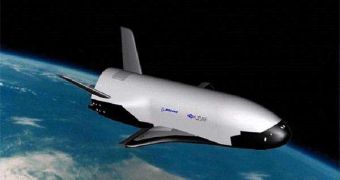When civilian companies manage a breakthrough that allows their spacecraft to go to the Earth's orbit, and then come back to the ground unharmed, they are sure to let everyone know about it. This does not seem to be the case with the United State Air Force (USAF), which develops its X-37B project under the cover of anonymity. It's not necessarily a big secret, it's just that the Air Force is not parading its reusable space vehicle around.
Space reports that the new airplane will be able to blast off from the Cape Canaveral Air Force Station, in Florida, reach low-Earth orbit, and then spend a large amount of time there, performing its mission. After its alloted time is spent, the X-37B will be able to pilot itself back to a runaway, most likely at the Edwards Air Force Base (EAFB), in California, completely autonomously. The spaceplane will be delivered to orbit inside an Atlas Evolved Expendable launch vehicle, shrouded in a protective shield.
Alongside the USAF and its various branches, NASA and the Defense Advanced Projects Research Agency (DARPA) have also been involved in the project, which has been ongoing for several years. Over the last few months, attempts made by reporters to get a comment about the project have been met with either the usual “no comment,” or with referrals to other agencies. Officials at the Pentagon, the USAF Space Command, and Boeing seem little inclined to comment about their new plane.
“NASA has a long history of involvement with the X-37 program. We continue to monitor and share information on technology developments. We are looking forward to a successful first flight and to receiving data from some advanced technologies of interest to us, such as thermal protection systems, guidance, navigation and control, and materials for autonomous re-entry and landing,” NASA Marshall Space Flight Center Science and Missions Systems Office chief engineer Gary Wentz says.
“The problem with it [X37-B] is whether you see it as a weapons platform. It then becomes, if I am not mistaken, a Global Strike platform. There are a lot of reasons to be concerned about Global Strike as a concept,” the Director of the United Nations Institute for Disarmament Research (UNIDIR), Theresa Hitchens, adds. She is the former head of the Center for Defense Information's Space Security Program.

 14 DAY TRIAL //
14 DAY TRIAL // 

